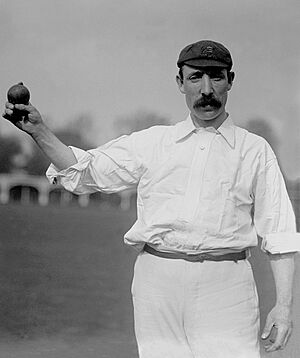Walter Mead (cricketer) facts for kids

Mead in about 1905
|
||||||||||||||||||||||||||||||||||||||||
| Personal information | ||||||||||||||||||||||||||||||||||||||||
|---|---|---|---|---|---|---|---|---|---|---|---|---|---|---|---|---|---|---|---|---|---|---|---|---|---|---|---|---|---|---|---|---|---|---|---|---|---|---|---|---|
| Born | 1 April 1868 Clapton, London, England |
|||||||||||||||||||||||||||||||||||||||
| Died | 18 March 1954 (aged 85) Shelley, Essex, England |
|||||||||||||||||||||||||||||||||||||||
| Batting | Right-handed | |||||||||||||||||||||||||||||||||||||||
| Bowling | Right-arm offbreak, Legbreak | |||||||||||||||||||||||||||||||||||||||
| International information | ||||||||||||||||||||||||||||||||||||||||
| National side | ||||||||||||||||||||||||||||||||||||||||
| Only Test | 15 June 1899 v Australia | |||||||||||||||||||||||||||||||||||||||
| Career statistics | ||||||||||||||||||||||||||||||||||||||||
|
||||||||||||||||||||||||||||||||||||||||
|
Source: CricInfo, 20 August 2021
|
||||||||||||||||||||||||||||||||||||||||
Walter Mead (born April 1, 1868, died March 18, 1954) was a famous English cricketer. He was a key bowler for the Essex team for many years. He also played an important role for the MCC and Ground team.
Walter Mead was a right-arm bowler. He bowled at a slow to medium speed. He was very good at keeping the ball in the right place. He could make the ball spin a lot, especially when the cricket pitch was wet from rain. He could also bowl a special ball that turned the other way.
Even though he was a bowler, he once surprised everyone. In 1902, he was sent in to bat late in the game. He scored an amazing 119 runs against Leicestershire. People were so impressed that they collected money for him as a reward!
Early Career and Success
Walter Mead was known as a great bowler even before Essex became a top-level team. In 1893, he took 17 wickets against the Australian touring team. A wicket is when a bowler gets a batsman out.
In 1894, Essex became a "first-class" county team. This meant they played against the best teams. Mead didn't do as well that year. But in 1895, he became super effective. He took 179 wickets that summer! This was a huge number of wickets for one season.
One of his best games was against Hampshire. He took 17 wickets in that match. This is one of the best bowling performances ever in first-class cricket.
Playing for England
The years 1896 and 1897 were a bit tough for Mead. The weather was very dry, which made the pitches hard. This made it harder for his spinning balls to work well. But he got better in the years that followed.
In 1899, he played very well against the Australian team again. Because of this, he was chosen to play in his only Test match for England. A Test match is the highest level of international cricket. He played this game at Lord's, a famous cricket ground. However, the pitch was very hard, and he didn't take many wickets in that match.
From 1899 to 1903, Walter Mead was one of the top bowlers in first-class cricket. In 1903, he was even named a Wisden Cricketer of the Year. This is a very special award in cricket. That year, he had the best bowling average among all first-class bowlers. He took 12 wickets in one match against Surrey. He also took 15 wickets in another match against Leicestershire.
Later Years and Retirement
After the 1903 season, Walter Mead stopped playing for Essex for a short time. This was due to a disagreement about his pay during the winter. Essex really missed him in 1904 and 1905.
By 1906, he agreed to come back and play for the team. He bowled very well that year, even though the summer was very dry. In 1907, he was still a very strong bowler, especially on softer pitches.
However, in 1908, his performance started to decline. He took fewer wickets than before. It became clear that his best playing days were behind him. He continued to play for a few more years. By 1912, it was clear his career was ending. He left the Essex team before the 1913 season finished.
Walter Mead left the Lord's ground staff in 1918. His son, Harold, also played some first-class cricket for Essex. Sadly, Harold passed away in 1921. He never fully recovered from injuries he got during World War I. Walter Mead lived to be 85 years old and passed away in 1954.

